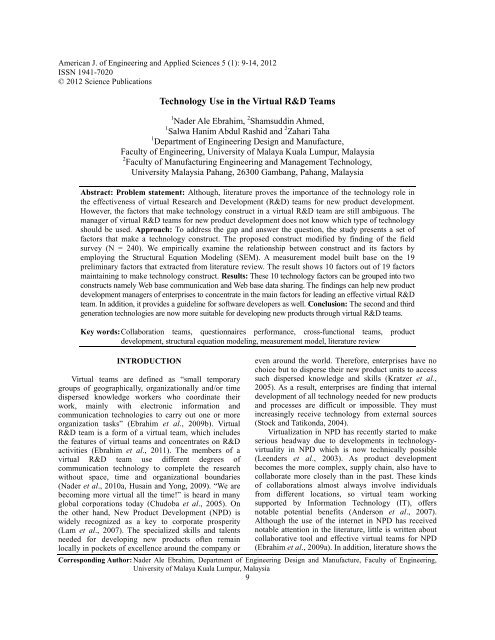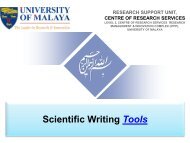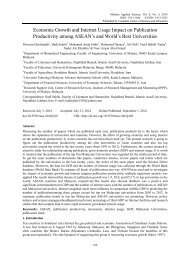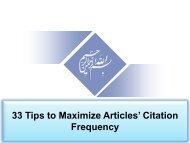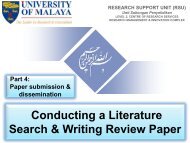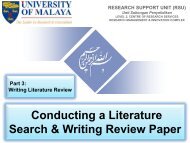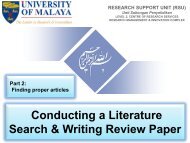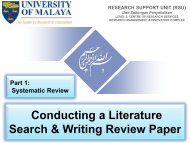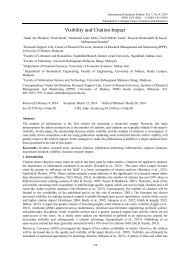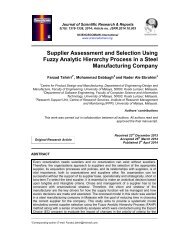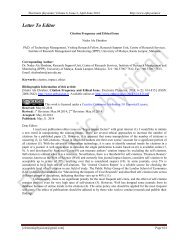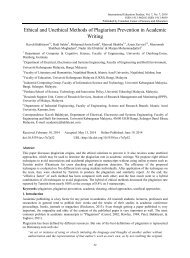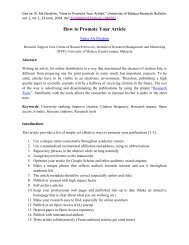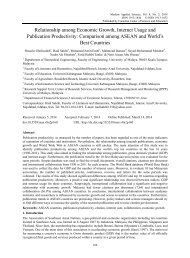Technology Use in the Virtual R
Create successful ePaper yourself
Turn your PDF publications into a flip-book with our unique Google optimized e-Paper software.
American J. of Eng<strong>in</strong>eer<strong>in</strong>g and Applied Sciences 5 (1): 9-14, 2012<br />
ISSN 1941-7020<br />
© 2012 Science Publications<br />
<strong>Technology</strong> <strong>Use</strong> <strong>in</strong> <strong>the</strong> <strong>Virtual</strong> R&D Teams<br />
1 Nader Ale Ebrahim, 2 Shamsudd<strong>in</strong> Ahmed,<br />
1 Salwa Hanim Abdul Rashid and 2 Zahari Taha<br />
1 Department of Eng<strong>in</strong>eer<strong>in</strong>g Design and Manufacture,<br />
Faculty of Eng<strong>in</strong>eer<strong>in</strong>g, University of Malaya Kuala Lumpur, Malaysia<br />
2 Faculty of Manufactur<strong>in</strong>g Eng<strong>in</strong>eer<strong>in</strong>g and Management <strong>Technology</strong>,<br />
University Malaysia Pahang, 26300 Gambang, Pahang, Malaysia<br />
Abstract: Problem statement: Although, literature proves <strong>the</strong> importance of <strong>the</strong> technology role <strong>in</strong><br />
<strong>the</strong> effectiveness of virtual Research and Development (R&D) teams for new product development.<br />
However, <strong>the</strong> factors that make technology construct <strong>in</strong> a virtual R&D team are still ambiguous. The<br />
manager of virtual R&D teams for new product development does not know which type of technology<br />
should be used. Approach: To address <strong>the</strong> gap and answer <strong>the</strong> question, <strong>the</strong> study presents a set of<br />
factors that make a technology construct. The proposed construct modified by f<strong>in</strong>d<strong>in</strong>g of <strong>the</strong> field<br />
survey (N = 240). We empirically exam<strong>in</strong>e <strong>the</strong> relationship between construct and its factors by<br />
employ<strong>in</strong>g <strong>the</strong> Structural Equation Model<strong>in</strong>g (SEM). A measurement model built base on <strong>the</strong> 19<br />
prelim<strong>in</strong>ary factors that extracted from literature review. The result shows 10 factors out of 19 factors<br />
ma<strong>in</strong>ta<strong>in</strong><strong>in</strong>g to make technology construct. Results: These 10 technology factors can be grouped <strong>in</strong>to two<br />
constructs namely Web base communication and Web base data shar<strong>in</strong>g. The f<strong>in</strong>d<strong>in</strong>gs can help new product<br />
development managers of enterprises to concentrate <strong>in</strong> <strong>the</strong> ma<strong>in</strong> factors for lead<strong>in</strong>g an effective virtual R&D<br />
team. In addition, it provides a guidel<strong>in</strong>e for software developers as well. Conclusion: The second and third<br />
generation technologies are now more suitable for develop<strong>in</strong>g new products through virtual R&D teams.<br />
Key words: Collaboration teams, questionnaires performance, cross-functional teams, product<br />
development, structural equation model<strong>in</strong>g, measurement model, literature review<br />
INTRODUCTION<br />
<strong>Virtual</strong> teams are def<strong>in</strong>ed as “small temporary<br />
groups of geographically, organizationally and/or time<br />
dispersed knowledge workers who coord<strong>in</strong>ate <strong>the</strong>ir<br />
work, ma<strong>in</strong>ly with electronic <strong>in</strong>formation and<br />
communication technologies to carry out one or more<br />
organization tasks” (Ebrahim et al., 2009b). <strong>Virtual</strong><br />
R&D team is a form of a virtual team, which <strong>in</strong>cludes<br />
<strong>the</strong> features of virtual teams and concentrates on R&D<br />
activities (Ebrahim et al., 2011). The members of a<br />
virtual R&D team use different degrees of<br />
communication technology to complete <strong>the</strong> research<br />
without space, time and organizational boundaries<br />
(Nader et al., 2010a, Husa<strong>in</strong> and Yong, 2009). “We are<br />
becom<strong>in</strong>g more virtual all <strong>the</strong> time!” is heard <strong>in</strong> many<br />
global corporations today (Chudoba et al., 2005). On<br />
<strong>the</strong> o<strong>the</strong>r hand, New Product Development (NPD) is<br />
widely recognized as a key to corporate prosperity<br />
(Lam et al., 2007). The specialized skills and talents<br />
needed for develop<strong>in</strong>g new products often rema<strong>in</strong><br />
locally <strong>in</strong> pockets of excellence around <strong>the</strong> company or<br />
even around <strong>the</strong> world. Therefore, enterprises have no<br />
choice but to disperse <strong>the</strong>ir new product units to access<br />
such dispersed knowledge and skills (Kratzer et al.,<br />
2005). As a result, enterprises are f<strong>in</strong>d<strong>in</strong>g that <strong>in</strong>ternal<br />
development of all technology needed for new products<br />
and processes are difficult or impossible. They must<br />
<strong>in</strong>creas<strong>in</strong>gly receive technology from external sources<br />
(Stock and Tatikonda, 2004).<br />
<strong>Virtual</strong>ization <strong>in</strong> NPD has recently started to make<br />
serious headway due to developments <strong>in</strong> technologyvirtuality<br />
<strong>in</strong> NPD which is now technically possible<br />
(Leenders et al., 2003). As product development<br />
becomes <strong>the</strong> more complex, supply cha<strong>in</strong>, also have to<br />
collaborate more closely than <strong>in</strong> <strong>the</strong> past. These k<strong>in</strong>ds<br />
of collaborations almost always <strong>in</strong>volve <strong>in</strong>dividuals<br />
from different locations, so virtual team work<strong>in</strong>g<br />
supported by Information <strong>Technology</strong> (IT), offers<br />
notable potential benefits (Anderson et al., 2007).<br />
Although <strong>the</strong> use of <strong>the</strong> <strong>in</strong>ternet <strong>in</strong> NPD has received<br />
notable attention <strong>in</strong> <strong>the</strong> literature, little is written about<br />
collaborative tool and effective virtual teams for NPD<br />
(Ebrahim et al., 2009a). In addition, literature shows <strong>the</strong><br />
Correspond<strong>in</strong>g Author: Nader Ale Ebrahim, Department of Eng<strong>in</strong>eer<strong>in</strong>g Design and Manufacture, Faculty of Eng<strong>in</strong>eer<strong>in</strong>g,<br />
University of Malaya Kuala Lumpur, Malaysia<br />
9
Am. J. Engg. & Applied Sci., 5 (1): 9-14, 2012<br />
factors that make technology construct <strong>in</strong> a virtual R&D<br />
team are still ambiguous. I this study we try to fill <strong>the</strong><br />
gap <strong>in</strong> <strong>the</strong> literature.<br />
This study is structured as follows. First, base on<br />
prior research we extract <strong>the</strong> 19 factors of technology<br />
construct <strong>in</strong> <strong>the</strong> virtual R&D teams. Next, Structural<br />
Equation Model<strong>in</strong>g (SEM) is used as <strong>the</strong> analytical tool<br />
for test<strong>in</strong>g <strong>the</strong> estimat<strong>in</strong>g and test<strong>in</strong>g <strong>the</strong> technology<br />
construct measurement models. Then adjust <strong>the</strong><br />
prelim<strong>in</strong>ary technology construct <strong>the</strong> model by fitt<strong>in</strong>g<br />
<strong>the</strong> model accord<strong>in</strong>g to <strong>the</strong> SEM fitness <strong>in</strong>dices and<br />
made a f<strong>in</strong>al measurement model. The study <strong>in</strong>fers with<br />
a discussion and future guidel<strong>in</strong>es.<br />
Literature review: <strong>Virtual</strong> teams use digital<br />
communications, video and audio l<strong>in</strong>ks, electronic<br />
whiteboards, e-mail, <strong>in</strong>stant messag<strong>in</strong>g, websites, chat<br />
rooms, as substitutes for physical collocation of <strong>the</strong><br />
team members (Baskerville and Nandhakumar, 2007,<br />
Pauleen and Yoong, 2001). Simple transmission of<br />
<strong>in</strong>formation from po<strong>in</strong>t A to po<strong>in</strong>t B is not enough; <strong>the</strong><br />
virtual environment presents significant challenges to<br />
effective communication (Walvoord et al., 2008). Be<strong>in</strong>g<br />
equipped with even <strong>the</strong> most advanced technologies are<br />
not enough to make a virtual team effective, s<strong>in</strong>ce <strong>the</strong><br />
<strong>in</strong>ternal group dynamics and external support<br />
mechanisms must also be present for a team to succeed <strong>in</strong><br />
<strong>the</strong> virtual world (Lurey and Rais<strong>in</strong>ghani, 2001). <strong>Virtual</strong><br />
teams are technology-mediated groups of people from<br />
different discipl<strong>in</strong>e that work on common tasks (Dekker et<br />
al., 2008) so <strong>the</strong> way <strong>the</strong> technology is implemented seems<br />
to make <strong>the</strong> virtual teams outcome more or less likely<br />
(Anderson et al., 2007). <strong>Virtual</strong> R&D team <strong>in</strong>structor<br />
should choose <strong>the</strong> suitable technology based on <strong>the</strong><br />
purpose of <strong>the</strong> team (Ebrahim et al., 2009c).<br />
Factors that make technology construct <strong>in</strong> a virtual<br />
R&D team are still ambiguous. We extracted 19-<br />
importance factors related to <strong>the</strong> technology construct,<br />
base on a comprehensive review on technology view <strong>in</strong><br />
<strong>the</strong> virtual R&D team work<strong>in</strong>g. Table 1 summarized <strong>the</strong><br />
factors and <strong>the</strong>ir supported references. E-mails and<br />
conference calls are generally known as first generation<br />
technologies while onl<strong>in</strong>e discussion boards, power<br />
po<strong>in</strong>t presentations, video tools and onl<strong>in</strong>e meet<strong>in</strong>g<br />
tools are second-generation technologies. Third<br />
generation technology refers typically to web-enabled<br />
shared workspaces with <strong>the</strong> <strong>in</strong>tranet or <strong>in</strong>ternet (Lee-<br />
Kelley and Sankey, 2008).<br />
Research method: To build a measurement model of<br />
technology construct <strong>in</strong> virtual R&D teams for new<br />
product development, we conducted a web-based<br />
survey ma<strong>in</strong>ly <strong>in</strong> Malaysian and Iranian manufactur<strong>in</strong>g<br />
enterprises, <strong>in</strong> a random sample of small and medium<br />
enterprises. Web-based survey method is selected<br />
because; it is a cost-effective and quick result to get<br />
feedback from <strong>the</strong> belief of <strong>the</strong> respondent. A Likert<br />
scale from one to five was used. This set up gave<br />
respondents a series of attitude dimensions. For each<br />
factor, <strong>the</strong> respondent was asked whe<strong>the</strong>r, <strong>the</strong> factor is<br />
not important or extremely important by us<strong>in</strong>g a Likert<br />
scale rat<strong>in</strong>g. The questionnaire was emailed to <strong>the</strong><br />
manag<strong>in</strong>g director, R&D manager, <strong>the</strong> new product<br />
development manager, project and design manager and<br />
suitable people who were most familiar with <strong>the</strong> R&D<br />
activities <strong>in</strong> <strong>the</strong> firm. The rapid expansion of Internet<br />
users has given web-based surveys <strong>the</strong> potential to<br />
become a powerful tool <strong>in</strong> survey research (Sills and<br />
Song, 2002, Nader et al., 2010b).<br />
Table 1: Summary of <strong>the</strong> factors related to <strong>the</strong> technology construct <strong>in</strong> <strong>the</strong> virtual teams<br />
Factor name Factor descriptions References<br />
Tech1 <strong>Use</strong> <strong>in</strong>ternet and electronic mail (Redoli et al., 2008, Pauleen and Yoong, 2001,<br />
Lee-Kelley and Sankey, 2008, Thissen et al., 2007)<br />
Tech2 Onl<strong>in</strong>e meet<strong>in</strong>g on need basis (Chen et al., 2007; Lee-Kelley and Sankey, 2008;<br />
Pena-Mora et al., 2000; Thissen et al., 2007)<br />
Tech3 Web conferenc<strong>in</strong>g (Coleman and Lev<strong>in</strong>e, 2007; Thissen et al., 2007,<br />
Zemliansky and Amant, 2008; Ebrahim et al., 2009c)<br />
Tech4 Sem<strong>in</strong>ar on <strong>the</strong> Web (Zemliansky and Amant, 2008)<br />
Tech5 Shared work spaces (Lee-Kelley and Sankey, 2008)<br />
Tech6 Video conferenc<strong>in</strong>g (Chen et al., 2007; Zemliansky and Amant, 2008)<br />
Tech7 Audio conferenc<strong>in</strong>g (Chen et al., 2007; Lee-Kelley and Sankey, 2008; Zemliansky<br />
Tech8 Onl<strong>in</strong>e presentations (Lee-Kelley and Sankey, 2008) and Amant, 2008)<br />
Tech9 Share documents (off-l<strong>in</strong>e) (Coleman and Lev<strong>in</strong>e, 2007; Ebrahim et al., 2009c)<br />
Tech10<br />
Share what’s on your computer desktop with people <strong>in</strong><br />
o<strong>the</strong>r locations (Remote access and control) (Thissen et al., 2007; Ale et al., 2009)<br />
Tech11 Do not <strong>in</strong>stall eng<strong>in</strong>eer<strong>in</strong>g software (Coleman and Lev<strong>in</strong>e, 2007; Kotelnikov, 2007,<br />
(get service through web browser) Vasileva, 2009)<br />
Tech12 Access service from any computer (<strong>in</strong> Network) (Thissen et al., 2007; Vasileva, 2009)<br />
Tech13 Standard phone service and hybrid services (Thissen et al., 2007; Ebrahim et al., 2009c)<br />
Tech14 Access shared files anytime, from any computer (Lee-Kelley and Sankey, 2008)<br />
Tech15 Web database (Coleman and Lev<strong>in</strong>e, 2007; Zemliansky and Amant, 2008;<br />
Ebrahim et al., 2009c)<br />
Tech16 Provide <strong>in</strong>stant collaboration (Coleman and Lev<strong>in</strong>e, 2007; Thissen et al., 2007)<br />
Tech17<br />
Software as a service (cancel<strong>in</strong>g <strong>the</strong> need to <strong>in</strong>stall and run<br />
<strong>the</strong> application on <strong>the</strong> own computer) (Coleman and Lev<strong>in</strong>e, 2007; Thissen et al., 2007)<br />
Tech18 <strong>Virtual</strong> research center for product development (Zemliansky and Amant, 2008)<br />
Tech19 Can be <strong>in</strong>tegrated/compatible with <strong>the</strong> o<strong>the</strong>r tools and systems (Coleman and Lev<strong>in</strong>e, 2007; Kotelnikov, 2007)<br />
10
Am. J. Engg. & Applied Sci., 5 (1): 9-14, 2012<br />
Invitation e-mails were sent to each respondent,<br />
reach<strong>in</strong>g 972 valid email accounts, with rem<strong>in</strong>ders<br />
follow<strong>in</strong>g every two weeks up to three months. 240<br />
enterprises completed <strong>the</strong> questionnaire, for an overall<br />
response rate of 24.7% Table 2.<br />
RESULTS<br />
Anderson and Gerb<strong>in</strong>g (1988) suggested us<strong>in</strong>g<br />
Confirmatory Factor Analysis (CFA) for scale<br />
development because it affords stricter <strong>in</strong>terpretation of<br />
unidimensionality than what is provided by more<br />
traditional approaches, such as coefficient alpha, itemtotal<br />
correlations and exploratory factor analysis. The<br />
evidence that <strong>the</strong> measures were one-dimensional,<br />
where a set of <strong>in</strong>dicators (factors) shares only a s<strong>in</strong>gle<br />
underly<strong>in</strong>g construct, was assessed us<strong>in</strong>g CFA<br />
(Anderson and Gerb<strong>in</strong>g, 1988). After data collection,<br />
<strong>the</strong> measures purification procedures should be used to<br />
assess <strong>the</strong>ir reliability, unidimensionality, discrim<strong>in</strong>ate<br />
validity and convergent validity (Anderson and<br />
Gerb<strong>in</strong>g, 1988).<br />
For reliability analysis, Cronbach’s Alpha<br />
(Cronbach, 1951) was employed to each factor. As<br />
shown <strong>in</strong> Table 3, all <strong>the</strong> items with Cronbach’s α<br />
greater than threshold 0.6 were <strong>in</strong>cluded <strong>in</strong> <strong>the</strong> analysis<br />
and <strong>the</strong> rest omitted from analysis. So, <strong>the</strong> factors<br />
Tech1, Tech10, Tech11 and Tech13 freed from fur<strong>the</strong>r<br />
analysis. In general, <strong>the</strong> reliability of <strong>the</strong> questionnaire’s<br />
<strong>in</strong>struments displayed a good reliability across samples.<br />
Structural Equation Model<strong>in</strong>g (SEM) us<strong>in</strong>g AMOS<br />
18 was employed for validation of <strong>the</strong> measurement<br />
model. This statistical analysis are estimated<br />
simultaneously for both <strong>the</strong> measurement and structural<br />
models (Dibrell et al., 2008). To ensure <strong>the</strong> factors<br />
make a right construct, <strong>the</strong> measurement model<br />
exam<strong>in</strong>ed for model fit. Given this, <strong>the</strong> model assessed<br />
for <strong>the</strong> convergent and discrim<strong>in</strong>ant validity.<br />
Table 2: Summarized onl<strong>in</strong>e survey data collection<br />
Numbers of emails sent enterprises 3625<br />
Total responses (Click <strong>the</strong> onl<strong>in</strong>e web page) 972.0<br />
Total responses / received questionnaire (%) 26.8<br />
Total completed 240.0<br />
Total completed / received questionnaire (%) 24.7<br />
Convergent validity was established us<strong>in</strong>g a<br />
calculation of <strong>the</strong> factor load<strong>in</strong>g, Average Variance<br />
Extracted (AVE) and Composite Reliability (CR). The<br />
factors that have standardized load<strong>in</strong>gs exceeded 0.50,<br />
were ma<strong>in</strong>ta<strong>in</strong>ed (Dibrell et al., 2008). The <strong>in</strong>itial<br />
measurement model was consist<strong>in</strong>g of 19 factors (Tech1<br />
to Tech19). After revis<strong>in</strong>g <strong>the</strong> measurement model by<br />
delet<strong>in</strong>g Tech1, Tech10, Tech11 and Tech13, <strong>the</strong> AVE<br />
and CR were calculated. AVE larger than 0.5 is <strong>the</strong><br />
threshold (McNamara et al., 2008). CR is calculated by<br />
squar<strong>in</strong>g <strong>the</strong> sum of load<strong>in</strong>gs, <strong>the</strong>n divid<strong>in</strong>g it by <strong>the</strong> sum<br />
of squared load<strong>in</strong>gs, plus <strong>the</strong> sum of <strong>the</strong> measurement<br />
error (L<strong>in</strong> et al., 2008). CR should be greater than 0.6<br />
(Huang, 2009). The measurement model had acceptable<br />
convergent validity s<strong>in</strong>ce <strong>the</strong> calculated CR and AVE<br />
were 0.930 and 0.613 respectively.<br />
For discrim<strong>in</strong>ant validity, we performed AMOS<br />
software us<strong>in</strong>g Maximum Likelihood method (ML).<br />
The fitt<strong>in</strong>g <strong>in</strong>dices checked with <strong>the</strong>ir respective<br />
acceptance values Table 4. We run <strong>the</strong> AMOS for <strong>the</strong><br />
model Ver1 (technology construct with 15 factors) and<br />
found a nonsignificant chi-square per degrees of<br />
freedom (CMIN/DF = 7.232). Most of <strong>the</strong> rest of fit<br />
<strong>in</strong>dices was not <strong>in</strong> <strong>the</strong> acceptable range.<br />
Table 3: Summary of <strong>the</strong> f<strong>in</strong>al measures and reliabilities<br />
Corrected item- Cronbach’s alpha<br />
Factor name total correlation if Item deleted<br />
Tech1 0.525 0.943<br />
Tech2 0.755 0.939<br />
Tech3 0.777 0.939<br />
Tech4 0.717 0.940<br />
Tech5 0.759 0.939<br />
Tech6 0.722 0.940<br />
Tech7 0.731 0.939<br />
Tech8 0.780 0.939<br />
Tech9 0.610 0.942<br />
Tech10 0.576 0.942<br />
Tech11 0.571 0.943<br />
Tech12 0.686 0.940<br />
Tech13 0.519 0.943<br />
Tech14 0.624 0.941<br />
Tech15 0.696 0.940<br />
Tech16 0.642 0.941<br />
Tech17 0.678 0.940<br />
Tech18 0.649 0.941<br />
Tech19 0.615 0.942<br />
Table 4: Fitt<strong>in</strong>g <strong>in</strong>dices (adopted from (Byrne, 2001)<br />
Fit Indices<br />
Desired range<br />
χ 2 /degrees of freedom (CMIN/DF) ≤ 2.00<br />
IFI (Incremental Fit Index) ≥ 0.90<br />
Comparative Fit Index (CFI) Coefficient values range from zero to 1.00, with values close to 0.95 show<strong>in</strong>g superior fit<br />
RMSEA (Root Mean Squire values less than .05 show good fit and values as high as .08 represent reasonable fit,<br />
Error of Approximation) from 0.08-0.10 show mediocre fit and those greater than 0.10 show poor fit<br />
Root mean square residual (RMR) ≤ 0.08<br />
Goodness-of-Fit Index (GFI) ≥ 0.90<br />
Normed Fit Index (NFI) Coefficient values range from zero to 1.00, with values close to 0.95 show<strong>in</strong>g superior fit<br />
Relative Fit Index (RFI) Coefficient values range from zero to 1.00, with values close to 0.95 show<strong>in</strong>g superior fit<br />
Tucker-Lewis Index (TLI) Values rang<strong>in</strong>g from zero to 1.00, with values close to 0.95 (for large samples) be<strong>in</strong>g <strong>in</strong>dicative of good fit<br />
11
Am. J. Engg. & Applied Sci., 5 (1): 9-14, 2012<br />
Fig. 1: Measurement model Ver2<br />
Thus, refer to <strong>the</strong> AMOS Modification Indices (MI)<br />
some of <strong>the</strong> factors that had <strong>the</strong> lowest factor load<strong>in</strong>g or<br />
<strong>the</strong> same effect of rema<strong>in</strong><strong>in</strong>g factor, were deleted. With<br />
this modification, <strong>the</strong> measurement model Ver2 had a<br />
significant chi-square per degrees of freedom<br />
(CMIN/DF = 4.767); o<strong>the</strong>r fit <strong>in</strong>dices, RMSEA, RMR<br />
and GFI also were <strong>in</strong> <strong>the</strong> acceptable range. Therefore,<br />
<strong>the</strong> best fitt<strong>in</strong>g model was <strong>the</strong> measurement model Ver2<br />
Fig. 1 and it used for fur<strong>the</strong>r analysis.<br />
DISCUSSION<br />
The f<strong>in</strong>al measurement developed made base on <strong>the</strong><br />
measurement model ver2 by classify<strong>in</strong>g <strong>the</strong> factors <strong>in</strong><br />
two groups accord<strong>in</strong>g to <strong>the</strong>ir relevant factor load<strong>in</strong>g<br />
with <strong>the</strong> threshold 0.83. The proper name for each<br />
group can be web base; communications and data<br />
shar<strong>in</strong>g respectively. As displayed <strong>in</strong> Fig. 2 each factor<br />
load<strong>in</strong>g was above 0.62 and significant. Overall, <strong>the</strong><br />
f<strong>in</strong>al measurement model produced good fit <strong>in</strong>dices<br />
(CMIN/DF = 2.889, RMR = .04, GFI = 0.929, RFI =<br />
0.929, NFI = 0.949, TLI = 0.952, CFI = 0.966 IFI =<br />
0.964, RMSEA = 0.089).<br />
While fitt<strong>in</strong>g <strong>the</strong> technology construct <strong>the</strong><br />
measurement model <strong>the</strong> factors Tech14 (access shared<br />
files anytime, from any computer), Tech15 (web<br />
database), Tech16 (provide <strong>in</strong>stant collaboration),<br />
Tech17 (software as a service (elim<strong>in</strong>at<strong>in</strong>g <strong>the</strong> need to<br />
<strong>in</strong>stall and run <strong>the</strong> application on <strong>the</strong> own computer))<br />
and Tech19 (can be <strong>in</strong>tegrated/compatible with <strong>the</strong><br />
o<strong>the</strong>r tools and systems) were dropped. Modification<br />
<strong>in</strong>dices (MI) base on regression weights shows Tech17,<br />
Tech 18 and Tech19 are highly correlated, so one<br />
representative (Tech18) from this group is enough.<br />
Tech14 to Tech16 are strongly correlated with Tech12,<br />
so <strong>the</strong> rema<strong>in</strong><strong>in</strong>g factor represents <strong>the</strong> deleted ones.<br />
12<br />
Fig. 2: F<strong>in</strong>al measurement model<br />
The results of <strong>the</strong> f<strong>in</strong>al measurement model of<br />
technology construct <strong>in</strong> virtual R&D team for<br />
develop<strong>in</strong>g a new product, shows <strong>the</strong> share of two ma<strong>in</strong><br />
contrasts, which are strongly correlated to each o<strong>the</strong>r:<br />
• Web base communications consists of onl<strong>in</strong>e<br />
meet<strong>in</strong>g on needed basis, web conferenc<strong>in</strong>g,<br />
sem<strong>in</strong>ar on <strong>the</strong> web, video conferenc<strong>in</strong>g, audio<br />
conferenc<strong>in</strong>g and onl<strong>in</strong>e presentations<br />
• Web base data shar<strong>in</strong>g consists of shared work<br />
spaces, share documents (off-l<strong>in</strong>e), access service<br />
from any computer (<strong>in</strong> network) and virtual<br />
research center for product development<br />
Accord<strong>in</strong>g to Lee-Kelley and Sankey (2008) <strong>the</strong>se<br />
two constructs belong to <strong>the</strong> second and third<br />
generation of technology. Equip virtual R&D team<br />
members with <strong>the</strong> suitable technology make <strong>the</strong> teams<br />
more effective. Therefore, <strong>the</strong> manager of NPD should<br />
provide <strong>the</strong> facilities and <strong>in</strong>frastructures for <strong>the</strong> virtual<br />
R&D teams to achieve <strong>the</strong> higher level of team<br />
effectiveness.<br />
CONCLUSION<br />
Research so far has explored <strong>the</strong> 19 factors for<br />
work<strong>in</strong>g toge<strong>the</strong>r virtually; however, us still less know<br />
about <strong>the</strong> factors which has ma<strong>in</strong> contributions <strong>in</strong> <strong>the</strong><br />
technology construct of <strong>the</strong> virtual R&D teams for New<br />
product development. The f<strong>in</strong>d<strong>in</strong>gs of this study extend<br />
<strong>the</strong> literatures and help to build a foundation for fur<strong>the</strong>r<br />
understand<strong>in</strong>g of <strong>the</strong> technology elements <strong>in</strong> <strong>the</strong> virtual<br />
R&D teams for new product development. The<br />
measurement model shows ten factors that make <strong>the</strong><br />
technology constructs. These ten factors can be sorted<br />
by <strong>the</strong>ir factor load<strong>in</strong>g which are reflect<strong>in</strong>g <strong>the</strong> factor<br />
weight. Therefore, <strong>the</strong> software developer or <strong>the</strong><br />
managers of <strong>the</strong> NPD are able to provide a better
platform for virtual team work<strong>in</strong>g by concentrat<strong>in</strong>g on<br />
<strong>the</strong> ma<strong>in</strong> factors. The second and third generation of<br />
technology (refer to def<strong>in</strong>ition of Lee-Kelley and<br />
Sankey (2008) is now more suitable for develop<strong>in</strong>g a<br />
new product through virtual R&D teams.<br />
Future research is needed to exam<strong>in</strong>e <strong>the</strong> effects of<br />
each factor to perform <strong>the</strong> virtual R&D teams while <strong>the</strong><br />
o<strong>the</strong>rs constructs of virtual teams such as process and<br />
people are present. A new SEM is needed to<br />
demonstrative <strong>the</strong> relationship between factorsconstructs<br />
and constructs-constructs which is not<br />
<strong>in</strong>vestigated yet <strong>in</strong> <strong>the</strong> literature.<br />
REFERENCES<br />
Ale, E., N. Ahme and Z. Taha, 2009. Innovation and<br />
<strong>Technology</strong> Facilitator University of Tehran.<br />
Anderson, A.H., R. Mcewan, J. Bal and J. Carletta,<br />
2007. <strong>Virtual</strong> team meet<strong>in</strong>gs: An analysis of<br />
communication and context. Comput. Human Behav.,<br />
23: 2558-2580. DOI: 10.1016/j.chb.2007.01.001<br />
Anderson, J.C. and D.W. Gerb<strong>in</strong>g, 1988. Structural<br />
equation model<strong>in</strong>g <strong>in</strong> practice: A review and<br />
recommended two-step approach. Psycholo. Bull.,<br />
103: 411-423. DOI: 10.1037/0033-2909.103.3.411<br />
Baskerville, R. and J. Nandhakumar, 2007. Activat<strong>in</strong>g<br />
and perpetuat<strong>in</strong>g virtual teams: Now that we’re<br />
mobile, where do we go? IEEE Trans. Profess.<br />
Commun., 50: 17-34. DOI:<br />
10.1109/TPC.2006.890849<br />
Byrne, B.M., 2001. Structural equation model<strong>in</strong>g with<br />
AMOS: Basic Concepts, Applications and<br />
Programm<strong>in</strong>g. 1st Edn., Routledge, USA., ISBN-<br />
10: 0805841040 pp: 352.<br />
Chen, M., Y. Liou, C.W. Wang, Y.W. Fan and Y.P.J. Chi,<br />
2007. TeamSpirit: Design, implementation and<br />
evaluation of a Web-based group decision support<br />
system. Decision Support Syst., 43: 1186-1202.<br />
DOI: 10.1016/j.dss.2005.07.008<br />
Chudoba, K.M., E. Wynn, M. Lu, B.M. Watson-<br />
Manheim, 2005. How virtual are we? Measur<strong>in</strong>g<br />
virtuality and understand<strong>in</strong>g its impact <strong>in</strong> a global<br />
organization. Inform. Syst. J., 15: 279-306. DOI:<br />
10.1111/j.1365-2575.2005.00200.x<br />
Coleman, D. and S. Lev<strong>in</strong>e, 2007. Collaboration 2.0 :<br />
technology and best practices for successful<br />
collaboration <strong>in</strong> a web 2.0 world. 1st Edn., Happy<br />
About, California, USA, ISBN-10: 1600050719<br />
pp: 320.<br />
Cronbach, L.J., 1951. Coefficient alpha and <strong>the</strong> <strong>in</strong>ternal<br />
structure of tests. Psychometrika, 16: 297-334.<br />
DOI: 10.1007/BF02310555<br />
Am. J. Engg. & Applied Sci., 5 (1): 9-14, 2012<br />
13<br />
Dekker, D.M., C.G. Rutte and V.D.P.T. Berg, 2008.<br />
Cultural differences <strong>in</strong> <strong>the</strong> perception of critical<br />
<strong>in</strong>teraction behaviors <strong>in</strong> global virtual teams. Int. J.<br />
Intercu. Relations, 32: 441-452. DOI:<br />
10.1016/j.ij<strong>in</strong>trel.2008.06.003<br />
Dibrell, C., P.S. Davis and J. Craig, 2008. Fuel<strong>in</strong>g<br />
Innovation through Information <strong>Technology</strong> <strong>in</strong><br />
SMEs. J. Small Bus. Manage., 46: 203-218. DOI:<br />
10.1111/j.1540-627X.2008.00240.x<br />
Ebrahim, N.A., S. Ahmed, Z. Taha, 2009a. Modified<br />
stage-gate: A conceptual model of virtual product<br />
development process. Afr. J. Marke. Manag, 1:<br />
211-219.<br />
Ebrahim, N.A., S. Ahmed, Z. Taha, 2009b. <strong>Virtual</strong><br />
R&D teams <strong>in</strong> small and medium enterprises: A<br />
literature review. Sci. Res. Essay, 4: 1575-1590.<br />
DOI: 10.2139/ssrn.1530904<br />
Ebrahim, N.A., S. Ahmed, Z. Taha, 2009c. <strong>Virtual</strong><br />
teams: A literature review. Australian J. Basic<br />
Applied Sci., 3: 2653-2669.<br />
Ebrahim, N.A., S.H.A. Rashid, S. Ahmed, Z. Taha,<br />
2011. The Effectiveness of <strong>Virtual</strong> R&D Teams <strong>in</strong><br />
SMEs: Experiences of Malaysian SMEs. Indu.<br />
Eng. Manag. Syst., 10: 109-114.<br />
Huang, C.C., 2009. Knowledge shar<strong>in</strong>g and group<br />
cohesiveness on performance: An empirical study<br />
of technology R&D teams <strong>in</strong> Taiwan.<br />
Technovation, 29: 786-797. DOI:<br />
1016/j.technovation.2009.04.003<br />
Husa<strong>in</strong>, A.J.A. and C.H. Yong, 2009. Utility-based<br />
policy management system for virtual organization.<br />
J. Comput. Sci., 5: 635-645. DOI:<br />
10.3844/jcssp.2009.635.645<br />
Kotelnikov, V., 2007. Kim Hak-Su Asia-Pacific<br />
Development Information Programme e-Primers<br />
for <strong>the</strong> Information Economy, Society and Polity.<br />
1st Edn., ISBN: 9789748283937, pp: 27.<br />
Kratzer, J., R.T.A.J. Leenders and J.M.L.V. Engelen,<br />
2005. Keep<strong>in</strong>g virtual R&D teams creative. CBS<br />
Interactive.<br />
Lam, P.K., K.S. Ch<strong>in</strong>, J.B. Yang and W. Liang, 2007.<br />
Self-assessment of conflict management <strong>in</strong> clientsupplier<br />
collaborative new product development.<br />
Indus. Manag. Data Syst., 107: 688-714. DOI:<br />
10.1108/02635570710750435<br />
Lee-Kelley, L. and T. Sankey, 2008. Global virtual<br />
teams for value creation and project success: A<br />
case study. Int. J. Project Manag. 26: 51-62. DOI:<br />
10.1016/j.ijproman.2007.08.010<br />
Leenders, R.T.A.J., J.M.L.V. Engelen and J. Kratzer,<br />
2003. <strong>Virtual</strong>ity, communication and new product<br />
team creativity: A social network perspective. J.<br />
Eng. Technol. Manag., 20: 69-92. DOI:<br />
10.1016/S0923-4748(03)00005-5
Am. J. Engg. & Applied Sci., 5 (1): 9-14, 2012<br />
L<strong>in</strong>, C., C. Stand<strong>in</strong>g and Y.C. Liu, 2008. A model to<br />
develop effective virtual teams. Decision Support<br />
Syst., 45: 1031-1045. DOI: 10.1016/j.dss.2008.04.002<br />
Lurey, J.S. and M.S. Rais<strong>in</strong>ghani, 2001. An empirical<br />
study of best practices <strong>in</strong> virtual teams. Inform.<br />
Manage., 38: 523-544. DOI: 10.1016/S0378-<br />
7206(01)00074-X<br />
Mcnamara, K., A.R. Dennis and T.A. Carte, 2008. It's<br />
<strong>the</strong> thought that counts: The mediat<strong>in</strong>g effects of<br />
<strong>in</strong>formation process<strong>in</strong>g <strong>in</strong> virtual team decision<br />
mak<strong>in</strong>g. Inform. Syst. Manage., 25: 20-32. DOI:<br />
10.1080/10580530701777123<br />
Nader, A.E., A. Shamsudd<strong>in</strong> and T. Zahari, 2010b.<br />
<strong>Virtual</strong> R&D teams and SMEs growth: A<br />
comparative study between Iranian and Malaysian<br />
SMEs. Afr. J. Bus. Manage., 4: 2368-2379.<br />
Nader, A.E., A. Shamsudd<strong>in</strong>, A. Rashid, S. Hanim and<br />
T., Zahari, 2010a. The Effectiveness of <strong>Virtual</strong><br />
R&D Teams <strong>in</strong> SMEs: Experiences of Malaysian<br />
SMEs. Proceed<strong>in</strong>gs of <strong>the</strong> 11th Asia Pacific<br />
Industrial Eng<strong>in</strong>eer<strong>in</strong>g and Management Systems<br />
Conference Dec. 9-9, Melaka, Malaysia. Kuala<br />
Lumpur, Malaysia: University of Malaya Press, pp:<br />
1-6.<br />
Pauleen, D.J. and P. Yoong, 2001. Facilitat<strong>in</strong>g virtual<br />
team relationships via Internet and conventional<br />
communication channels. Int. Res., 11: 190-202.<br />
DOI: 10.1108/10662240110396450<br />
Pena-Mora, F., K. Husse<strong>in</strong>, S. Vadhavkar and K.<br />
Benjam<strong>in</strong>, 2000. CAIRO: A concurrent eng<strong>in</strong>eer<strong>in</strong>g<br />
meet<strong>in</strong>g environment for virtual design teams.<br />
Artif. Intell. Eng., 14: 203-219. DOI:<br />
10.1016/S0954-1810(00)00016-9<br />
Redoli, J., R. Mompo, J. Garcia-Diez and M. Lopez-<br />
Coronado, 2008. A model for <strong>the</strong> assessment and<br />
development of Internet-based <strong>in</strong>formation and<br />
communication services <strong>in</strong> small and medium<br />
enterprises. Technovation, 28: 424-435. DOI:<br />
10.1016/j.technovation.2008.02.008<br />
Sills, S.J. and C. Song, 2002. Innovations <strong>in</strong> survey<br />
research an application of web-based surveys. Soc.<br />
Sci. Comp. Rev., 20: 22-30. DOI:<br />
10.1177/089443930202000103<br />
Stock, G.N. and M.V. Tatikonda, 2004. External<br />
technology <strong>in</strong>tegration <strong>in</strong> product and process<br />
development. Int. J. Oper. Production Manage., 24:<br />
642-665. DOI: 10.1108/01443570410541975<br />
Thissen, M.R., J.M. Page, M.C. Bharathi and T.L.<br />
Aust<strong>in</strong>, 2007. Communication tools for distributed<br />
software development teams. Proceed<strong>in</strong>gs of <strong>the</strong><br />
2007 ACM SIGMIS CPR Conference on Computer<br />
Personnel Research: The Global Information<br />
<strong>Technology</strong> Workforce. New York, DOI:<br />
10.1145/1235000.1235007<br />
Vasileva, S.E., 2009. Authority-based and bottom-up<br />
diffusion of collaboration <strong>in</strong>formation<br />
technologies: Constra<strong>in</strong>ts and enablements. mba<br />
(mgmt <strong>in</strong>formation systems). Universitat<br />
Koblenz-Landau.<br />
Walvoord, A.A.G., E.R. Redden, L.R. Elliott and M.D.<br />
Coovert, 2008. Empower<strong>in</strong>g followers <strong>in</strong> virtual<br />
teams: Guid<strong>in</strong>g pr<strong>in</strong>ciples from <strong>the</strong>ory and practice.<br />
Comput. Human Behav., 24: 1884-1906. DOI:<br />
10.1016/j.chb.2008.02.006<br />
Zemliansky, P. and K.S. Amant, 2008. Handbook of<br />
Research on <strong>Virtual</strong> Workplaces and <strong>the</strong> New<br />
Nature of Bus<strong>in</strong>ess Practices. 1st Edn., IGI<br />
Global Snippet, Hershey PA, ISBN-10:<br />
159904871X, pp: 733.<br />
14


